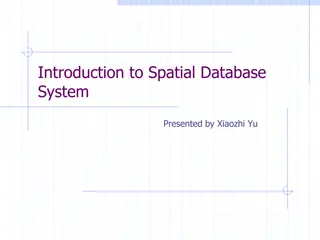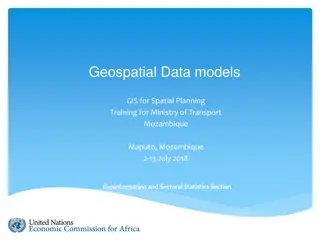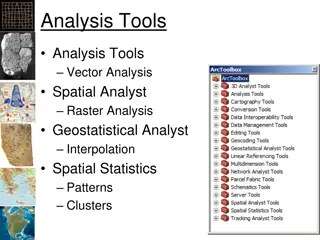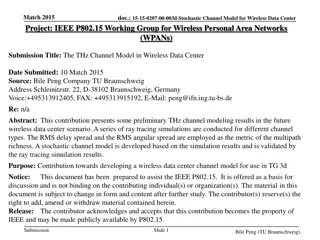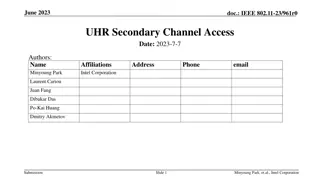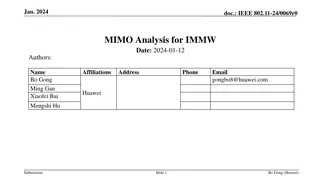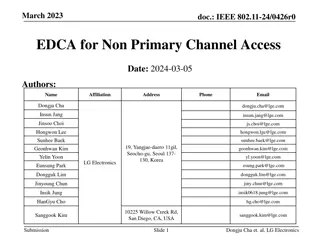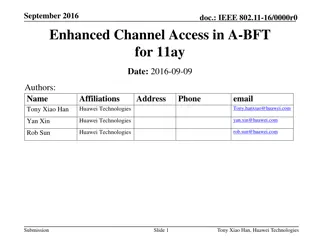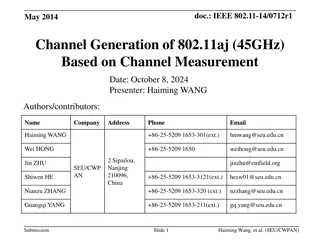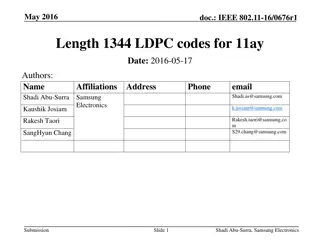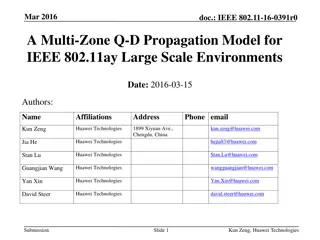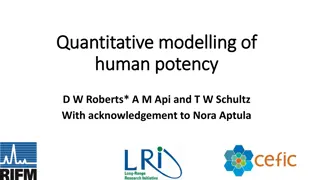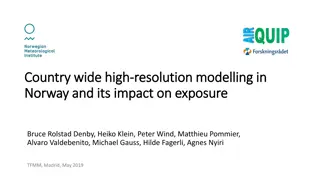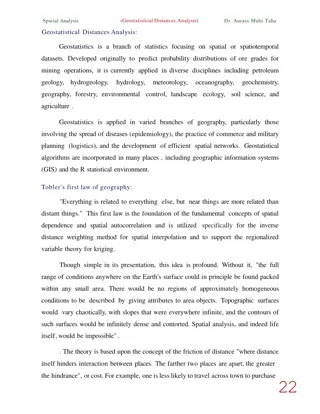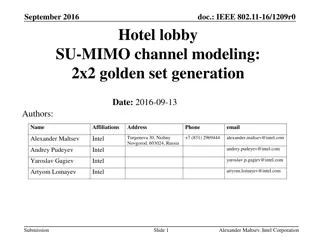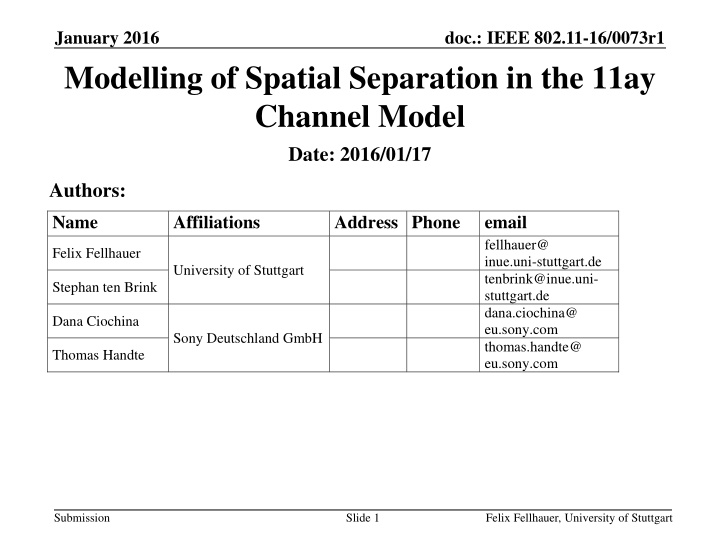
Spatial Separation Modelling in 11ay Channel Model
Explore the proposal for extending IEEE 802.11ad channel models to cater to future MIMO scenarios in 802.11ay, focusing on spatial separation of phased array antennas (PAA) and different MIMO configurations. The review includes insights into channel modeling and direct link-based approaches for effective communication.
Download Presentation

Please find below an Image/Link to download the presentation.
The content on the website is provided AS IS for your information and personal use only. It may not be sold, licensed, or shared on other websites without obtaining consent from the author. If you encounter any issues during the download, it is possible that the publisher has removed the file from their server.
You are allowed to download the files provided on this website for personal or commercial use, subject to the condition that they are used lawfully. All files are the property of their respective owners.
The content on the website is provided AS IS for your information and personal use only. It may not be sold, licensed, or shared on other websites without obtaining consent from the author.
E N D
Presentation Transcript
January 2016 Modelling of Spatial Separation in the 11ay Channel Model Date: 2016/01/17 doc.: IEEE 802.11-16/0073r1 Authors: Name Affiliations Address Phone email fellhauer@ inue.uni-stuttgart.de tenbrink@inue.uni- stuttgart.de dana.ciochina@ eu.sony.com thomas.handte@ eu.sony.com Felix Fellhauer University of Stuttgart Stephan ten Brink Dana Ciochina Sony Deutschland GmbH Thomas Handte Submission Slide 1 Felix Fellhauer, University of Stuttgart
January 2016 doc.: IEEE 802.11-16/0073r1 Abstract This contribution summarizes the existing proposal for the extension of legacy IEEE 802.11ad channel models to cover future MIMO use cases in 802.11ay. Further concepts are proposed for modelling spatial separation of phased array antennas (PAA). Submission Slide 2 Felix Fellhauer, University of Stuttgart
January 2016 doc.: IEEE 802.11-16/0073r1 Introduction The 11ay channel model shall support multiple hybrid MIMO configurations [1] Configurations to be supported 1. 1 PAA, single pol., 2 SS 2. 1 PAA, dual pol., 2 SS 3. 2 PAA, single pol., 2 SS 4. 2 PAA, dual pol., 4 SS 5. 1 PAA, dual pol., 1 SS Spatial separation Configurations 1, 2, 5 feature a single PAA (?1,2= 0) Configurations 3, 4 feature two PAAs with ?1,2 0 ?1,2 0 How to model channel for Config. 3, 4? Target: Reuse mature 11ad SISO-Model as much as possible Focus here on Config. 3, Config. 4 is a straightforward extension Submission Slide 3 Felix Fellhauer, University of Stuttgart
January 2016 doc.: IEEE 802.11-16/0073r1 Review of submission [1] (Intel) Channel model in Configuration 3 from [1]: ( ( ) ( ) ( ( ( ) ) ( ( ) ) ( ( ) ) ( ) ( ) e ) ) H H H H H ch i ch i H ch i ch i e H e U U V V e H e U U V V = H V i V H i V 1 H 1 2 H 1 i eff H H H H ch i ch i ch i ch i H e U U V V e H e U U V V V i H H i H 1 2 2 2 Properties Channel derived from a single omnidirectional channel-impulse- response (CIR) tap realization H? ?? ?? and ?? (? = 1,2) model antenna weight vectors (AWVs) Assumptions distance between PAAs is assumed to be zero, i.e. ?1= ?2= 0 all PAAs see the same channel ??,?? ?? model antenna responses at RX and TX of a single PAA Submission Slide 4 Felix Fellhauer, University of Stuttgart
January 2016 doc.: IEEE 802.11-16/0073r1 Review of submission [2] (InterDigital) Submission Slide 5 Felix Fellhauer, University of Stuttgart
January 2016 doc.: IEEE 802.11-16/0073r1 Direct link based approach Channel model for ??,??> ? ( ( ) ) ( ( ) ) H H e H e e H e ( , ) ( , ) ( , ) ( , ) g g g g 1 1 1 1 1 1 2 2 RX RX TX TX RX RX TX TX = V i e V H i e V , 1 , 2 H i eff H H e H e H ( , ) ( , ) ( , ) ( , ) g g g g 2 2 1 1 2 2 2 2 RX RX TX TX RX RX TX TX V i H H i H , 1 , 2 Properties Channel derived from ??? (here two) independent omnidirectional CIR tap realizations ??,?and ??,? ?(?,?) approximates PAA response by Gaussian gain pattern as in 11ad [3] Assumptions distance between PAAs is large, i.e. ?1,?2> 0 actually two independent SISO links no control of ?1,?2 Submission Slide 6 Felix Fellhauer, University of Stuttgart
January 2016 doc.: IEEE 802.11-16/0073r1 Comparison of channel models Intel [1]: micro structure = macro structure Direct link based approach: micro structure macro structure Scenario: Conference Room STA-AP, NLOS, 2x2 MIMO, 90 beamwidth 49 beams per TX / RX, equal seeds for both graphs, SNR=20dB Submission Slide 7 Felix Fellhauer, University of Stuttgart
January 2016 doc.: IEEE 802.11-16/0073r1 Options for modeling spatial separation Channel model ( ( ) ( ) ( ( ( ) ) ( ( ) ) ( ( ) ) ( ) ( ) e ) ) H H H H H ch i ch i H ch i ch i e H e U U V V e H e U U V V = H V i V H i V 1 H 1 2 H 1 i eff H H H H ch i ch i ch i ch i H e U U V V e H e U U V V V i H H i H Options 1. Modify ?? 1 2 2 2 ? and ?? ? Consider response of complete array of subarrays, instead of response of a single subarray e.g., for an antenna with two ULAs, inter-ULA separation ? and intra-ULA separation ?? (equal for TX & RX) and number of total sub-elements ( ) ( ) RX RX e N i U ( ) ( ) i RX ( ) i TX ch i ch i 1 , 1 , U V ( ) ( ) 1 1 ( ) i RX ( ) i TX = = ch i ch i U V 2 2 ( ) ( ) ( ) j d d N j d d N ( ) ( ) t t ( ) i ( ) i TX N ch ch i x x x x 1 , 1 , V e TX Amplitudes of rays + polarization, AoAs and AoDs can be reused from .11ad model ?? and ??shaped to fit the dimensions of ?? ? and ?? ? Submission Slide 8 Felix Fellhauer, University of Stuttgart
January 2016 doc.: IEEE 802.11-16/0073r1 Options for modeling spatial separation Channel model ( ( ) ( ) ( ( ( ) ) ( ( ) ) ( ( ) ) ( ) ( ) e ) ) H H H H H ch i ch i H ch i ch i e H e U U V V e H e U U V V = H V i V H i V 1 H 1 2 H 1 i eff H H H H ch i ch i ch i ch i H e U U V V e H e U U V V V i H H i H Options 1. Modify ?? For 2 rectangular arrays 1 2 2 2 ? and ?? ? (cont.) The phase variations for elements of first PAA = , ( ( y k sin = The phase variations for elements of second PAA d N d k + = ( , ??the number of subantenna elements of the first PAA + k d n ) ) k d n nx ny x x x y y ) ) y ( ( ( ) i RX ( ) i RX 2 = sin cos k x ( ) i RX ( ) i RX 2 sin d + ) n k d n nx ny x x x x x y y y Figure from [1] With the phase variations as above, the phasors can be written as in [1] Submission Slide 9 Felix Fellhauer, University of Stuttgart
January 2016 doc.: IEEE 802.11-16/0073r1 Options for modeling spatial separation Channel model ( ( ) ( ) ( ( ( ) ) ( ( ) ) ( ( ) ) ( ) ( ) e ) ) H H H H H ch i ch i H ch i ch i e H e U U V V e H e U U V V = H V i V H i V 1 H 1 2 H 1 i eff H H H H ch i ch i ch i ch i H e U U V V e H e U U V V V i H H i H Options 2. Use ??? ??? different channel realizations ?? (here 4) ??= ?(?1,?2), i.e. dependent on the inter-PAA distances ?1,?2 Requires simple raytracing algorithm within the channel model Simple raytracing based geometric reflections More precise control over the amplitudes, AoA/AoDs of all rays Low complexity alternative: Definition of quasi-static set of TX / RX positions and raytracing results for comparability no need for raytracer implementation within channel model 1 2 2 2 Submission Slide 10 Felix Fellhauer, University of Stuttgart
January 2016 doc.: IEEE 802.11-16/0073r1 Conclusion Analysis of different approaches of the .11ay channel model with respect to spatial separation all PAAs see the same omnidirectional channel (Intel) [1] ??? ??? independent CIRs and angular rotation (InterDigital) [2] ??? independent CIRs (direct link based approach) Proposal of further options to model spatial separation 1. phase variations 2. different channel realizations 3. combination of 1 and 2 Recommendation Have a clear specification regarding modelling of inter-PAA distance Option 2 seems reasonable Submission Slide 11 Felix Fellhauer, University of Stuttgart
doc.: IEEE 802.11-16/0073r1 January 2016 References A. Maltsev et al, Extension of Legacy IEEE 802.11ad Channel Models for MIMO and Channel Bonding , IEEE doc. 11-15/1356r1. R. Yang and A. Sahin, Feasibility of SU-MIMO under Array Alignment Method , IEEE doc. 11-15/1333r0. A. Maltsev et al, Channel Models for 60 GHz WLAN Systems , IEEE doc. 11-09/0334r8. 1. 2. 3. Submission Slide 12 Felix Fellhauer, University of Stuttgart
January 2016 doc.: IEEE 802.11-16/0073r1 APPENDIX Submission Slide 13 Felix Fellhauer, University of Stuttgart
January 2016 doc.: IEEE 802.11-16/0073r1 Comparison of approaches InterDigital [2]: Intel [1]: Direct link based Approach: red: changes with respect to 11ad SISO channel model implementation Submission Slide 14 Felix Fellhauer, University of Stuttgart



